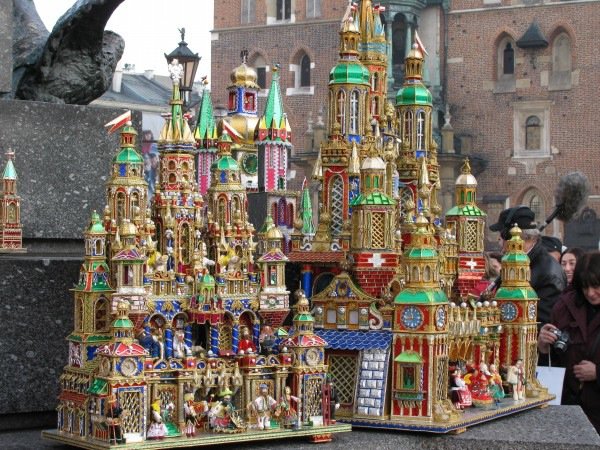Some great Polish Christmas traditions Posted by Kasia on Dec 20, 2015 in Culture
Christmas is coming! Although it doesn’t feel like it in New Hampshire right now…No snow and 50 degrees! I think this is the first Christmas since I moved here without snow;(
I miss Poland and Polish Christmas! I’m really hoping to spend next Christmas in Poland with my family…Today I can just think about how special this time would be:)
Midnight Mass (Msza o północy/Pasterka), the Christmas Tree (Choinka), carol singing (kolędowanie), the giving of presents – these are all traditions which the Poles share with other European nations, though other customs like hanging elegant Christmas stockings are not widely followed. Family arguments, dodgy pop songs and spicy dishes which children aren’t necessarily desperate to eat – those are not ruled out either. But let’s not get carried away with the Scroogey side of Christmas (although it would be interesting to find a good Polish translation of the word ‘humbug’) as Poland has many marvelous traditions of her own, some of them deeply moving.
Here are few of my favorites:
Szopki (Nativity Scenes) – These are often translated as cribs, but the classic Cracovian szopka looks more like the kind of coloured castle that you find in a Russian fairy tale.
In the olden days, nativity scenes provided a pleasant way of making a bit of extra cash for masons. When snow stalled construction projects, craftsmen would sell szopki and other ornaments for Christmas to well-to-do Cracovian households. In more recent times, an annual competition was instated, partly as a means of keeping the tradition alive. This entered its 63rd year in 2005.
The contest begins every year on the first Thursday of December, when the entrants (including everyone from youngsters to jovial old grandpas) bring their creations to the Mickiewicz statue on theMarket Square. At midday, the bugle cry announces that the scenes should be whisked away to theHistorical Museum, where judges will decide on the winner. The following weekend the winners are announced and the year’s pickings are put on display.
Święty Mikołaj – (St. Nicholas’ Day) Polish children are blessed with the exciting prospect of two present extravaganzas. The 6th of December is the Day of St. Nicholas, the kindly saint so commonly associated with Father Christmas. A few weeks before the big day, children write letters to the old fellow (often posting them by hand to the post office or leaving them on the window sill etc.). If the little monsters have been good, the bountiful saint will bring rewards…..In my house Mikołaj would always leave little gifts under the pillows at night:)
Wigilia (Christmas Eve) – is the most sacred day in Poland’s yuletide calendar, culminating in the breaking of the ‘opłatek’ blessed wafer and sharing holiday wishes with loved ones, often a deeply emotional moment.
The central element of Wigilia is a twelve course dinner without meat, the number of dishes symbolizing both the months of the year and the twelve apostles. A dash of hay is placed on the table, recalling the manger, and the celebration begins when the first star appears in the sky. This was always my favorite part…My family (with a lot of cousins) would always wait for the first star to appear in the sky…all of the kids were in the window looking for it!
Opłatek – Before the dinner begins, pieces of ‘opłatek’ are handed around, and prayers are said. Thoughts turn to those members of the family who are not present, and an intensely reflective atmosphere takes hold.
The tradition of opłatek took off during the nineteenth century when many Polish families were separated, most famously after waves of patriots were dispatched to Siberia for rising up against Russian rule. Blessed wafers were sent to relatives in exile and divided families held parallel observances. Although an opłatek is inexpensive today, they often come imprinted with beautiful seasonal imagery. In the countryside, farm animals are also given oplatek as it was they who first greeted the baby Jesus. On this night, it’s believed that the goodly animals talk in human voices.
There are many, many more beautiful Polish Christmas traditions…Which one is your favorite? Let us know in comments below!
Wesołych Świąt!

Build vocabulary, practice pronunciation, and more with Transparent Language Online. Available anytime, anywhere, on any device.
About the Author: Kasia
My name is Kasia Scontsas. I grew near Lublin, Poland and moved to Warsaw to study International Business. I have passion for languages: any languages! Currently I live in New Hampshire. I enjoy skiing, kayaking, biking and paddle boarding. My husband speaks a little Polish, but our daughters are fluent in it! I wanted to make sure that they can communicate with their Polish relatives in our native language. Teaching them Polish since they were born was the best thing I could have given them! I have been writing about learning Polish language and culture for Transparent Language’s Polish Blog since 2010.





Comments:
Thomas Dorozynski:
When you break and pass the wafer on Xmas eve what do you say to the recipient in Polish
Kasia:
@Thomas Dorozynski Hi Tom! You usually wish your family and friends happy New Year, wonderful time spend together, lot’s of health and happiness!
Thomas Dorozynski:
Wesolych Swiat. Tom